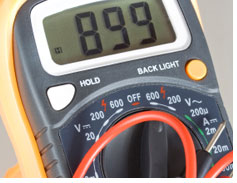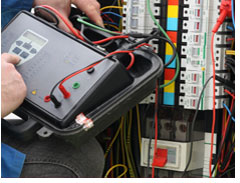 |
Unit 2, 16 Forest Road Kingswood, Bristol BS15 8EG Tel: 0117 935 3047 Fax: 0117 960 3339 email: info@avonleaelectricalcontractors.co.uk |
 |
 |
 |
 |
Testing - Pat TestingAvonlea Electrical Contractors Ltd also provide Pat testing services or portable appliance testing is an important part of any health and safety policy. Maintaining PAT records has become a statutory requirement and is therefore considered good practice of any organisation. There are a number of reasons why appliances should be tested with the most important ones being:
Periodic Inspection and TestingA Periodic Inspection and Testing (PIR) is an inspection on the condition of an electrical installation, to identify any deficiencies against the national safety standard on electrical installations. A Periodic Inspection and Testing (PIR) examines and evaluates the electrical installation's safety, and/or deterioration due to a number of factors, such as damage, wear, tear, corrosion, excessive electrical loading, ageing and environmental influences, or items of none compliance which may give rise to danger. Periodic testing assures you and the inspectors of a safe working environment for employees as well as providing landlords with certification for the safety of tenants. Why is Periodic Inspection and Testing (PIR) needed? As every electrical installation deteriorates with age and use, it is essential that they are maintained in order to ensure that the safety of others is not put at risk. Legalisation requires that all electrical installations are kept in a safe working condition. A fixed electrical installation includes all parts of a distribution system from the main supply point, through to wiring accessories such as sockets and light fittings - and everything in between. Because the majority of this part of the installation is unseen, it is often forgotten in terms of test and inspection. The fact is that it is vitally important that all wires, cables, accessories and switching equipment are maintained well in order to ensure safety. The process of an Electrical Safety Inspection Test, involves a similar process to that of PAT, in that a thorough visual inspection is carried out along with electronic tests. Engineers are looking to identify any potentially dangerous defects within the system that may lead to fire or injury. The benchmark for this inspection and test process is BS7671 (The IEE Wiring Regulations) which provides guidance on how systems must be designed, installed and maintained. Deviations from this British Standard are most likely to be the cause of any problems. After an initial visual inspection, several electronic tests are carried out by injected test voltage and current through the system to determine the integrity and functionality of cables, accessories and disconnection devices. This form of test and inspection is paramount to safety in the workplace. Avonlea Electrical Contractors Ltd is unique, in that we offer our customers a remedial solution to repair any defects found during the test and inspection process. Our electrical installation division will prepare a no obligation quotation to repair any deviations from BS7671 and provide the required certification in each case. We can provide Periodic Inspection Certificates, Minor Works Certificates and Electrical Installation Certificates. We are often being asked to provide an Electrical Safety Certificate. All of these can be provided Emergency Lighting & Fire Alarm TestingAvonlea Electrical Contractors Ltd provides an essential testing and certification services of Emergency Lighting Systems & Fire Alarm Systems. Whether you already have a testing and maintenance programme in place or are starting from scratch, we are able to help you fulfil your safety obligations by providing a reliable and cost effective testing service for both Emergency Lighting (Inclusive of central Battery Unit Systems) and Fire Alarm Inspection & Testing. Emergency Lighting TestingWhy does it need to be tested? Emergency lighting systems are installed to provide assistance in evacuating a building in the event of loss of the supply to the general lighting circuits through fire or a power cut for instance. The Fire Precautions (workplace) Regulations 1997 state that "Emergency routes and exits requiring illumination must be provided with emergency lighting of adequate intensity in case lighting fails". It is the responsibility of all employers to ensure that all these systems are suitably maintained and checked to ensure they are safe and compliant. All emergency lighting systems should now be installed, tested and inspected in accordance with BS5266-1. What does it involve? Emergency Lighting Testing requires that every circuit supplying an emergency light is isolated to demonstrate that the internal batteries in the emergency fitting keep the exits and exit routs illuminated during power failures. Every 12 months a full discharge test (1hr or 3hr, dependent on system installed) must be performed by a competent person to ensure the batteries are capable of lasting for the required period. Each light is inspected to ensure it operates correctly and that the lamp inside is functional. Furthermore our electrician will check that there are a sufficient number of lights and that the correct evacuation legends are fitted during the test visit to the premises. Upon completion of the test we will provide a report on any necessary repairs or improvements that may be required before issue of test certificate. Fire Alarm & Fire Detection Systems Inspection & TestingWhy does it need to be tested? Fire alarm and fire detection systems are designed and installed as an early warning system to the inhabitants of buildings, that danger of fire in imminent. A system that in correctly designed , installed and maintained will ensure that all inhabitants have adequate time to evacuate a building and alert the fire authorities in good time. The Fire Precautions (workplace) Regulations 1997 requires that fire alarm and automatic detection systems should be installed where there is a requirement for early warning of fire. Periodic test and inspection of all fire alarm and detection systems is essential, to ensure they will operate correctly in the event of a fire; poor maintenance can lead to failure of these systems with catastrophic consequences. It is the responsibility of all employers to ensure that these systems are suitably maintained and checked to ensure they are safe and compliant. All fire alarms and detection systems should now be installed, tested and inspected in accordance with BS5839 pt 1. What does it involve? Fire alarm and detection system test and inspection involves a series of visual checks being carried out on the components of the system to ensure their integrity, this will include cables, containment, panels, detectors and sounders. Whilst this type of work is completely non-evasive, it will also be necessary for our inspecting electrician to carry out a fire alarm drill which involves triggering the alarm system via a detector or break-glass unit. Upon completion of the test and inspection a report of any remedial action, if applicable, will be provided before issue of a TEST Certificate. If you require further information on our testing services, please contact us. For a FREE ESTIMATE on any of our services |


